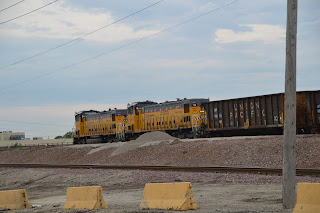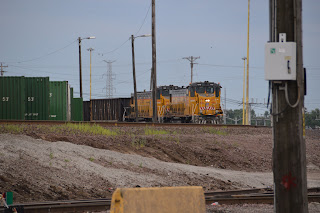 |
| Fred Van Dorpe post Satellite |
 |
| 20190630 8367 |
A roster shot of #1111.
But I noticed that I could see the top of the hump and other stuff. So I took a sequence of wide-angle shots turning to my right to get an overview of what you can see from the parking lot.
Then I took another "railfan photo."
But I was more interested in the yard towers and intermodal equipment. Note the tank car on the left that is the beginning of a cut of cars that is going to be shoved over the hump.
Even though it was a Sunday, a cut of cars was being shoved over the hump. This video wasn't worth uploading.
But this one I did upload at 2x speed. You can see the top of some of the cars as they roll down the hump.
(new window)
I stopped the video because they were spending some time getting this autorack car to go. It finally went and they started shoving cars again.
An overview of the cars in the cut.
Turning to the left, we can see that the hump yard lead curves to the North.
I stopped the video because the sun had come out, and I wanted to take some more railfan photos of #1111. As Murphy's Law would have it, the sun went away as I got the camera off the tripod. This photo notes that there was no need to wait for the sun to come back out. It is like that long black cloud was designed to keep me from having some sun again.
And then I heard a noise. As you can see from the black exhaust, the noise was the starting of the Translift. So I put the camera back in the tripod.
I set the zoom lens so that I could catch the hump and the Translift at the same time. Even with double the action, things are still slow so this video is also 2X. I could not believe how long it took to hook the UPS trailer. Since it is a Sunday, was it a trainee? Are all lifts that slow? I couldn't tell because once it set out the high priority UPS trailer, it went to the other end where I could not see what was happening.
(new window)
After I got bored with the video, I took a max zoom (200mm) photo of the far end so that I could later digitally zoom in to see what was happening with the Translift. I can't figure it out.
Some of the power parked near the hump tower. Given the different cab and the exhaust stacks, these are gensets that are designed for doing yard work with reduced pollution.
Back to taking photos of the far end so that I can study them later. I took a sequence so that I could record movement. In particular, one of the Translifts starts moving to the right.
 |
| 19:10:03 |
 |
| 19:12:00 |
 |
| 19:13:56 |
 |
| 19:14:42 |
 |
| 19:14:52 |
A photo with view blocks but it shows that only three locomotives were parked here.
Some overview and closeup shots as I leave this part of the yard.
The Translift that was moving to the right has made some progress.
 |
| 19:20:20 |
I discovered a (Sunday) parking spot along the access road so I could get out and take photos of the hump lead that goes off to the north.
Any fallen flag is worthy of a closeup.
Or two.
It used to be that about everything, including grain, was hauled in boxcars. After Southern Railroad developed the covered hopper for grain cargo, some railroads refused to buy them because they originally were used primarily during harvest season. (Now trucks are used for the harvest rush and hoppers are used year round for hauling grain from big interior grain elevators to markets such as ports for export and chicken farms in the southeast. And railroads do now buy and supply hoppers. I have seen unit trains consisting entirely of new CSX and BNSF hoppers.) But back to the early history of hoppers. Companies that needed to haul grain either bought their own or did long term leases. Since the cars were dedicated to them, they put their logo on them. You can tell this is an old paint job not only because of the rust but because it has a logo. Or the remnants of one. It is strange that it doesn't include the company's name.
Taking photos of cars in a hump shove is easy because they move so slowly. So I grabbed some details to study later.
Are these aluminum ignots? If so, they are still heavy because these cars are probably loaded close to 286,000 pounds.
A video that just panned the cut from right to left. It is not worth uploading.
The end of the shove is getting closer to this access road.
 |
| 19:28:40 |
There are supposed to be numbers in that placard.
Even when I zoom in, I can't find numbers.
 |
| Camera Resolution |
Providence & Worchester Railroad
It used to be that taggers did just the flat surface of boxcars. But boxcars have become rare enough that I guess they decided autoracks are flat enough.
The end is in sight.
(new window)
I went back to the parking lot to get another zoom shot of the distant Translift action.
 |
| 19:35:38 |
In the meantime, the end of the shove has made it to the parking lot area.
I'm back to the access road along the north/south road and I spot a couple of regular locomotives rolling past. An advantage of taking photos is that I now notice what I did not see at the time---there is a worker standing on the front platform. That makes sense since the locomotives are going backwards. He is the engineer's eyes.
I took video of the locomotives rolling by. But it can be summed up...
...with the following screenshot @ 0:22. This catches them (#4380 and #5790) after they have turned into the light, the dirt on #5790, the rise of the hump lead in the foreground and a safety slogan.
These are the two locomotives shoving the hump yard cut on the lead's curve.
While waiting for traffic to clear on Lake Street, I took photos of the old (near) and new (far) underpasses. Note the wood timbers next to the abutment for the old underpass.
I had seen this logo on a previous trip to this area, so I circled around to it and parked the car to check it out. I thought the bridge would have been replaced by now.
This is the west side of the underpass of North Avenue under UP/C&NW north of their Proviso Yard. (street view)
These photos show abandonment is not the reason they didn't replace this bridge. It is obviously still being used, even on a Sunday. Note how little traffic is on North Ave during a Sunday evening.
Back home, as I approached my driveway, I had noticed an eastbound intermodal was rolling across Main Street. Then I noticed some westbound pumpkins (orange locomotives). So I parked the car in the driveway, grabbed the camera, set the zoom at max (200mm), took a still photo to focus the lens, and then a video snippet of two intermodal trains on The Racetrack.
Unfortunately, it seemed to have focused on the tree trunk on the right. My new lens has a manual focus feature. According to the user manual, there are two ways to use it. But the one I thought I understood doesn't seem to work. So it is time to study the user manual some more. Once again, a video can be summed up with a screenshot (0:11) The orange container is on the eastbound train, which is behind the westbound that has the red and white containers. There is such a big gap because both w/b platforms in the foreground are domestic (53') platforms carrying international (40') containers.




















































No comments:
Post a Comment